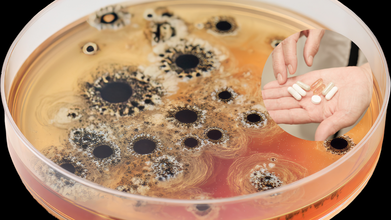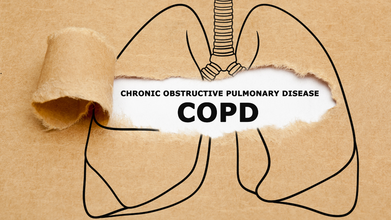- Health Conditions A-Z
- Health & Wellness
- Nutrition
- Fitness
- Health News
- Ayurveda
- Videos
- Medicine A-Z
- Parenting
What Happens When Antibiotics Stop Working? Reveals Doctor

Credits: Canva
What happens when antibiotics stop working? We are so used to consuming antibiotics for everything that slowly our bodies are rejecting this. The sole reason is that bacteria have become smart. And experts believe that if this continues, it could slip the world back into an era where even a minor infection would be dangerous.
Antibiotics are used to treat almost all infections. However, with the sudden outbreaks, the misuse and overuse of it is slowly leading to antibiotic resistance or antimicrobial resistance (AMR). As per the World Health Organization (WHO), AMR occurs when bacteria, viruses, fungi, and parasites no longer respond to antimicrobial medicines.
What could Happen When Antibiotics Stop Working?
As experts warn, infections we currently consider minor could soon turn life-threatening. A routine urine infection, a scraped knee, or a mild chest infection, problems that usually resolve within days, may refuse to heal in the future. Bacteria evolve rapidly, and when exposed to unnecessary or incomplete antibiotic courses, they adapt and learn to survive. That’s when even our strongest medicines begin to fail.
Antibiotics do far more than treat common illnesses; they quietly support some of the most advanced medical procedures.
“Joint replacements, heart surgeries, organ transplants all rely on antibiotics to prevent dangerous infections. Chemotherapy patients, whose immunity is low, survive because antibiotics protect them from everyday microbes. Remove this safety net, and suddenly these sophisticated treatments become far riskier, even impossible,” explained Dr. Sunil Havannavar Senior Consultant - Internal Medicine, Manipal Hospital Sarjapur to IndiaTV.
How Does Antimicrobial Resistance Spread?
Antibiotic resistance doesn’t arrive with a bang. It builds slowly, every time antibiotics are misused—taken for viral infections, stopped halfway through, used without prescription, or demanded unnecessarily for fevers. Each misuse gives bacteria an opportunity to evolve. Doctors are already seeing cases where high-power, last-resort antibiotics are needed for infections that should have been easily treatable.
In fact, a new global study in The Lancet’s eClinicalMedicine has drawn serious concern about the sharp rise of antimicrobial resistance (AMR) in India, placing the country at the centre of what many specialists now consider a fast-moving superbug crisis. The research, titled Preprocedural screening for multidrug-resistant organisms in endoscopic retrograde cholangiopancreatography: an international, multicentre, cross-sectional observational study, shows that Indian patients had the highest worldwide rates of multidrug-resistant organisms (MDROs) among those undergoing a common endoscopic procedure.
A superbug is a strain of bacteria that no longer responds to one or more groups of antibiotics that previously worked well. This can happen through enzyme production such as carbapenemases, changes in drug targets, increased pumping out of drugs or shifts in the cell wall that block antibiotics from entering, as per National Institute of Health. When bacteria gain resistance to several antibiotic classes, the list of possible treatments becomes very small. Such resistance makes infections tougher to manage because routine medicines no longer work, leading to more severe illness.
What We Can Still Do to Stop This Future
The situation is serious, but not irreversible. We can slow the rise of resistance if everyone plays their part.
- Doctors can prescribe antibiotics only when necessary.
- Patients can avoid demanding them for every fever or throat ache.
- Everyone must finish the full antibiotic course when prescribed.
- Hospitals can strengthen hygiene and infection control.
- Farmers can limit antibiotic use in livestock.
- Scientists can continue developing new medicines and vaccines.
Can Male Infertility Be Cured Without Medical Intervention?

Credits: Canva
Nearly one in seven couples struggles with infertility, meaning they haven’t been able to conceive despite having regular, unprotected sex for a year or more. In roughly half of these couples, male infertility is at least partially responsible. Causes can range from low sperm production and abnormal sperm function to blockages that prevent sperm delivery.
Illnesses, injuries, chronic conditions, lifestyle factors, and other influences may contribute. Not being able to conceive can be stressful and emotionally challenging, but a variety of treatments exist for male infertility. But are there natural ways to improve male fertility? We spoke with Dr. Ruchi Jain, Fertility Specialist at Nova IVF Fertility, Kolkata, to get her insights.
What Is Male Infertility?
Male infertility refers to a man’s inability to cause pregnancy in a fertile female partner, often due to problems with sperm production, function, or delivery. After a year of trying (or six months if the woman is over 35) without success, doctors usually examine both partners. About 50% of infertility cases involve male factors, with the most common issues being low sperm count (oligospermia), poor motility, abnormal morphology, or the complete absence of sperm in the ejaculate (azoospermia), Dr Jain explained. Some causes are temporary, some treatable, and some may be permanent.
Can Male Infertility Be Treated Naturally?
Many men experience noticeable improvement by focusing on lifestyle changes and addressing reversible medical conditions. Research shows that a nutritious diet (like a Mediterranean-style or “prudent” diet), regular moderate exercise, quitting smoking, reducing alcohol, losing excess weight, and avoiding heat or tight underwear can improve sperm quality.
Dr. Jain noted, “These adjustments don’t guarantee conception, but they often enhance sperm count, motility, and DNA quality enough to support natural conception or assisted reproductive techniques.”
Medical Fixes That Can Restore Fertility
Certain medical conditions that cause infertility can often be reversed. For example, varicoceles, which are enlarged veins in the scrotum—are a common cause; repairing a significant varicocele frequently improves semen parameters and can lead to pregnancy.
Hormonal issues, such as low testosterone or pituitary disorders, may also be treated with medication. Dr. Jain said, “Temporary causes like infections, medications, or recent fevers can lower sperm counts, which often normalize within a few months once the underlying issue is resolved. Professional guidelines highlight that many male-factor infertility cases can respond well to medical or surgical treatment.”
Is Male Infertility Permanent?
Dr Jain told us that some conditions are extremely difficult or impossible to “cure.” Genetic disorders (like Klinefelter syndrome), congenital absence of the vas deferens, severe testicular failure, or damage from chemotherapy or radiation usually prevent normal sperm production.
In these cases, treatment focuses on alternatives: retrieving sperm directly from the testicles, using IVF with ICSI (intracytoplasmic sperm injection), donor sperm, or adoption. Recent studies show that sperm retrieval after certain procedures can improve success rates, but outcomes depend heavily on the underlying condition of the testicles.
What About Supplements, Herbs, and “Natural” Cures?
Interest in antioxidants (vitamins C and E, zinc, L-carnitine), herbal remedies (maca, ginseng), and bioactive compounds (resveratrol, curcumin) is rising. Some research reports modest improvements in sperm quality, while other studies show mixed or minimal effects.
However, experts caution that supplements aren’t a miracle solution, quality varies, and evidence remains limited. Always consult a specialist before trying supplements, as some may interact with medications or cause harm at high doses.
Big-Picture Threats and Prevention
Even with personal lifestyle changes, environmental factors play a major role. Global air pollution, pesticides, plastics, and other endocrine-disrupting chemicals are linked to long-term declines in sperm counts. While an individual cannot control these entirely, reducing exposure (avoiding unnecessary plastics, limiting contact with heat or chemicals, choosing organic or well-washed produce) and advocating for public health measures are practical steps. Recent global reviews have highlighted these environmental threats to male fertility.
How To Reverse Male Infertility?
Male infertility is not always permanent. Many causes, such as obstructions, varicoceles, hormonal imbalances, or infections—can be treated or reversed. Lifestyle changes and certain medical or surgical interventions can improve outcomes for many men.
Conversely, genetic factors, severe testicular damage, and gonadotoxic injuries are usually irreversible, requiring assisted reproductive techniques or other family-building options. A structured diagnostic assessment and an individualized treatment plan—including genetic counseling when needed are essential.
Taking Magnesium And Melatonin Together? Here’s How It Affects Your Sleep

Credits: Canva
Magnesium and melatonin are both popular supplements, especially among people looking to get more shuteye, but can combining them improve your sleep? Some research indicates that taking magnesium and melatonin together could improve sleep quality, though stronger, larger studies are needed to confirm the effect.
Can We Combine Magnesium and Melatonin To Support Sleep?
Studies on using magnesium and melatonin together are limited, but some evidence suggests it could benefit sleep in certain individuals.
Also Read: China’s ‘Zombie Cell’ Pill Claims To Extend Human Life To 150—Could It Work?
As per Health, one study focusing on women with polycystic ovary syndrome found that taking both magnesium and melatonin improved sleep quality. Another study reported that people with sleep difficulties who used a combined magnesium-melatonin supplement for four weeks noticed modest improvements in how well they slept.
The exact reason why the two work together is not completely understood, but magnesium and melatonin may influence each other in a way that supports sleep.
“Magnesium does have an effect on melatonin levels,” said Marie van der Merwe, PhD, coordinator of the applied physiology and nutrition doctoral program at the University of Memphis, speaking to Health. “The amount of magnesium you have can influence how well your body produces melatonin.”
You don’t necessarily need to take the two supplements at the same time to benefit, van der Merwe noted. It’s fine to take magnesium in the morning and melatonin before bed.
The takeaway: There could be a link between magnesium and better sleep, but more research is needed to be sure.
Magnesium And Sleep
Magnesium is a vital mineral that supports nerve and muscle function, regulates blood pressure and blood sugar, and contributes to the formation of bone, protein, and DNA. As per Mayo Clinic, it is also commonly taken to help with sleep, but it is not without risks.
Benefits of Magnesium for Sleep
Some studies suggest magnesium may help sleep by:
Improving sleep quality: Ensuring adequate magnesium through diet or supplements may help people with deficiencies sleep better and ease anxiety.
Reducing muscle tension: Magnesium can help relax muscles and relieve tension, which can make it easier to fall asleep.
Risks of Magnesium for Sleep
Research on magnesium for sleep is limited. Supplements aren’t regulated by the FDA for safety or effectiveness and carry potential risks:
Delayed effect: It may take several weeks before magnesium supplements noticeably improve sleep.5
Side effects: High doses can cause diarrhea, nausea, and stomach cramps.7
Drug interactions: Magnesium can interfere with some medications, reducing their effect or increasing side effects. Talk to a doctor before starting any new supplement.7
Melatonin And Sleep
Melatonin is a well-known sleep aid, though it’s actually a hormone your body naturally produces to regulate sleep-wake cycles.⁸ “Melatonin is in charge of running the [internal] clock, and it really is important for regulating your circadian rhythms,” van der Merwe said.
Benefits of Melatonin for Sleep
Works quickly when needed: Unlike magnesium, melatonin can act soon after taking it, making it useful for occasional sleepless nights.
May help you fall asleep faster: Studies show that a 2-milligram dose of melatonin helped some people fall asleep about nine minutes sooner than placebo.
Supports sleep timing: Melatonin can help shift workers, travelers with jet lag, or those with irregular sleep schedules align their sleep patterns.
Risks Of Melatonin For Sleep
Melatonin can help with some sleep difficulties but won’t fix all sleep disorders, van der Merwe said. Like magnesium, melatonin isn’t FDA-regulated:
Long-term effects unclear: There’s limited data on the safety of long-term melatonin use.
Medication interactions: Melatonin may interact with antibiotics, antidepressants, and birth control.
Caution for certain groups: It’s generally not recommended for children or people with dementia, and should be used carefully by those with seizures or on blood thinners.
What to Consider Before Taking Magnesium and Melatonin Together?
It’s wise to speak with a healthcare professional before starting any new supplements, alone or in combination.
Van der Merwe emphasized that sleep problems can stem from issues that supplements alone won’t fix. Conditions like cardiovascular disease, type 2 diabetes, and depression can affect sleep.
If you want to try one or both supplements, a doctor can help determine the best timing for magnesium, melatonin, or a combined product.
“Melatonin [should] increase at night,” van der Merwe explained, so it is crucial to take it at the right time. Taking it in the morning can disrupt your internal clock.
Even though sleep-support supplements like magnesium and melatonin have grown in popularity, it’s important to consult a professional to see if they will help in your situation.
Why COPD Is Now Affecting People in Their 20s and 30s

Credits: Canva
Chronic obstructive pulmonary disease (COPD) has long been seen as a condition of older adults, typically tied to years of smoking. But across India, pulmonologists are increasingly diagnosing it in people in their 20s and 30s. This shift, experts say, reflects a deeper and more troubling change: young adults are growing up and living in environments where the lungs never truly get a chance to breathe clean air.
A Shift From “Smoker’s Disease” to “Exposure Disease”
The biggest change is the cause itself. As Dr. Raja Dhar, Director & HOD, Pulmonology, CK Birla Hospitals, CMRI Kolkata, explains, “COPD is increasingly becoming an ‘exposure disease’ rather than a ‘smoker’s disease.’ In India, non-smoking COPD is numerically a much larger problem.”
This exposure begins early—sometimes in childhood.
Dr. Dhar highlights how even limited exposure can have lifelong consequences: “Severe airway obstruction can be traced back to just six to seven years of biomass smoke exposure in a poorly ventilated kitchen during a child’s formative years.”
Dr. Harshil Alwani, Consultant – Pulmonology, CK Birla Hospitals, Jaipur, also points to the changing risk profile. According to him, “newer epidemiological data show that non-smoking drivers—especially air pollution and occupational exposures—are playing a disproportionately large role in younger people.” He adds that rapid urbanisation means more young adults are chronically breathing polluted air from childhood onwards.
Improved diagnosis and greater awareness also mean younger patients with persistent symptoms are now being evaluated more often, he notes.
Beyond Smoking: The Real Culprits Behind Early COPD
Air Pollution
Both experts agree that polluted air is the biggest trigger today. Dr. Alwani explains that long-term exposure to PM₂.₅ is directly linked to lung decline and COPD. “Recent research shows that temperature and humidity modulate the harmful effect of PM₂.₅, making COPD risk worse under certain climatic conditions,” he says.
Dr. Dhar adds that India’s air quality is deteriorating nationwide: “Ambient outdoor air pollution is a severe risk, as air quality across 98% of India is worse than WHO standards.”
Indoor Pollution
Household pollution remains a massive issue. Biomass fuel used for cooking is, as Dr. Dhar puts it, “the largest non-smoking contributor, resulting in numbers approximately three times that of smoking-related COPD.”
Occupational Hazards
Young adults working in construction, mining, welding, or factory settings face daily exposure to dust, fumes, and chemicals. Dr. Alwani notes that such environments “carry a significantly increased risk.”
Childhood Lung Infections
Recurrent infections can impair lung development and reduce lung reserve, making early-onset disease more likely.
Genetic Factors
Conditions like alpha-1 antitrypsin deficiency, though rare, still contribute when combined with environmental triggers.
Delhi’s Winter Pollution: A Direct Route to Lung Damage
Every winter, Delhi’s smog becomes a health emergency. According to Dr. Dhar, “High winter pollution, particularly hazardous levels of PM2.5, acts as a chronic, low-grade chemical burn on the young respiratory system.”
Dr. Alwani adds that winter inversion traps pollutants closer to the ground, amplifying PM₂.₅’s damage.
The Vaping Problem
Vaping and e-cigarettes, widely perceived as harmless, have added a new layer of risk. Dr. Alwani warns, “Vaping is not benign. Its aerosols contain volatile compounds, heavy metals, and ultrafine particles that trigger inflammation and oxidative stress—central pathways to COPD.”
Dr. Dhar echoes this concern: “Any inhalation of heated chemical aerosols is a significant lung irritant and pro-inflammatory agent.”
Symptoms Young Adults Should Never Ignore
Doctors urge young adults not to dismiss symptoms like:
- Persistent cough
- Breathlessness during routine activity
- Wheezing or chest tightness
- Frequent colds or bronchitis
- Fatigue or reduced stamina
Why Early Diagnosis Matters
Early spirometry can dramatically change outcomes. As Dr. Dhar puts it, “Early intervention allows us to remove the source of exposure and start therapy, which can effectively preserve the patient’s remaining lung function.”
Dr. Alwani adds that catching the disease early can “significantly slow further lung damage” and prevent long-term complications.
© 2024 Bennett, Coleman & Company Limited

